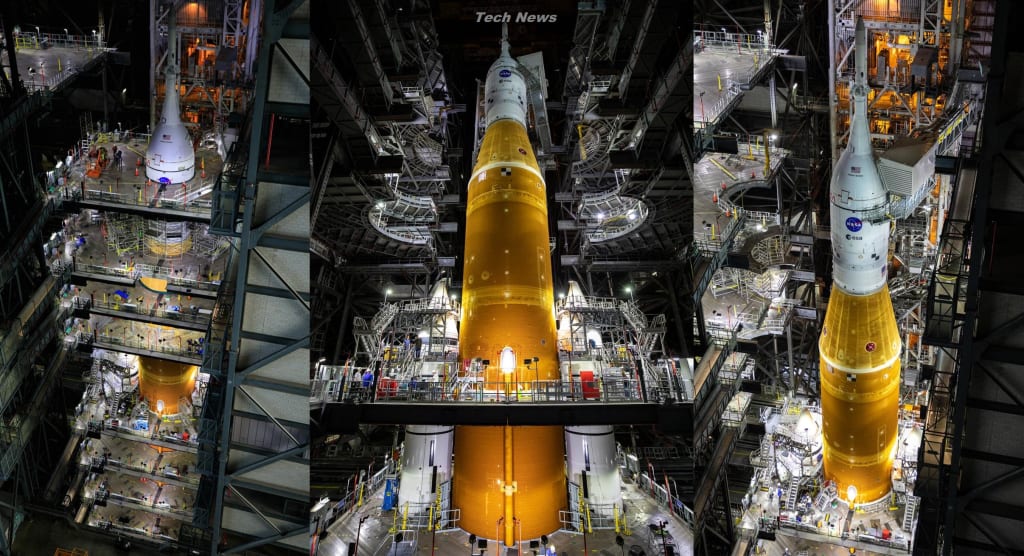
NASA's space launch system will take the lunar rocket back to the vehicle assembly building at the Kennedy Space Center to replace faulty valves and repair hydrogen leaks found during launchpad testing, the agency announced Saturday night.
It was not known on Saturday when the pushback could occur, or how long the unplanned return to VAB could delay the final launch of the big moon rocket on NASA's Artemis 1 test flight. The mission was launched for some time in early June, but its reversal could delay the often-delayed test flight at the end of the summer.
NASA officials will brief reporters at 3 p.m. EDT (1900 GMT) on Monday to discuss its plans to bring SLS Moon Rocket back to the Assembly building. The 98-meter (322-foot) rocket moved to Launch Complex 39B last month in preparation for the countdown test.
The rocket will launch an unmanned Orion Mand capsule around the moon on a test flight before sending astronauts on NASA's second SLS / Orion mission. The Artemis program aims to send astronauts back to the moon by the end of this decade.
The purpose of the practice countdown on the Pad 39B is to detect problems and ensure that SLS lunar rockets and ground systems are ready for launch day.
NASA's launch team failed to fully load the space rocket's lunar rocket with extremely cold liquid hydrogen and liquid oxygen during three attempts this month. An issue with the fans prevented the teams from loading the rocket with propellant on April 3, and an incorrectly configured valve on the launch pad interrupted the second test of the tank on April 4.
NASA also found a failed helium check valve in the upper phase of the rocket. Managers decided to drop the propellant load on the upper stage during rehearsals for the third countdown on Thursday.
The launch team had a problem with the supply of gas nitrogen from Air Liquid, a contractor operating an offsite plant and delivering the gases to the space center via a pipeline. Gas nitrogen is used to clean rocket parts to reduce the risk of fire during propellant loading.
Nitrogen gas flow was restored and NASA began loading propellant into the main phase on Thursday afternoon. The liquid oxygen tank of the main phase was about 49% full, but the flow of liquid hydrogen stopped at 5% point after the engineers discovered the leakage of hydrogen.
The leak was located near the tail service mast, the connection where cryogenic propellants flow from the rocket's mobile launch pad into the main phase.
During the countdown test on April 4, there was also a problem with the nitrogen supply of Air Liquid, which delayed the start of propellant loading for several hours that day.
"Due to the necessary upgrades to the third-party nitrogen gas supplier used for the test, NASA will take the opportunity to bring the SLS and Orion back into the vehicle's assembly building to replace the defective upper-stage check valve and a small tail service mast. "During this time, the agency will also review schedules and options for demonstrating propellant loading operations before launch," NASA said in a statement.
During Thursday's countdown rehearsal, Jeremy Parsons, deputy program manager for NASA's Ground Exploration System in Kennedy, tweeted, "Hydrogen is extremely dangerous, cold and a small molecule known for its leaks." "All of these systems have been sealed, leaks checked, and wet clothes checked as much as possible before rehearsals."
But leak checks between the SLS cover stage and the mobile launch pad, up to recent fueling tests, have been carried out at warmer ambient temperatures. Liquid hydrogen fuel is cooled to minus 423 degrees Fahrenheit (minus 253 degrees Celsius) and liquid oxygen is stored at minus 297 degrees Fahrenheit (minus 183 degrees Celsius).
Read More...






Comments
There are no comments for this story
Be the first to respond and start the conversation.